In
this issue:
Peter Dahmen's Wild Ride
A Magical Paper Retreat in Italy Daniel MAR Curates His Collection


In

One of the best things about directing the MBS is being aware of and feeling inspired by the extraordinary things that our community is doing every day. After reading this issue, I'm feeling inspired by intrepid workshop participants, immersive making experiences, and the instructors who provide opportunity. I'm inspired by collectors and their enthusiasm for collections. I'm overwhelmed and inspired by the technical and aesthetic virtuosity of our engineers. Here's a virtual toast to our community, and to an INSPIRATIONAL 2023!"
Shawn Sheehy, Director, MBSThough this will likely never be in print for us collectors, a new work of art by Peter Dahmen demands recognition nevertheless. So we are proud to share this remarkable piece of work here in our pages. We also look forward to learning even more as Peter will be our keynote speaker at the fall conference in Ohio this year. Ok. NOW I expect ticket sales to start really popping!
A few very lucky people recently traveled to Italy for the Art of Paper workshop, and four, now FIVE, MBS members were among them. Our newest member, Ron Shaull, shares the experience, along with notes from paper engineer and professor, Carol Barton.

Daniel MAR of France shows us how he puts his collection in rotation for all his visitors to enjoy. Lovely job, Daniel.
And again, peruse our ongoing report of New Releases, as well as the new and late breaking news of paper engineers plus our always-informative guide to movable book events from Ellen G. K. Rubin in Poppits.
Finally, MBS is producing cards of their own. Now is YOUR chance to support our chapter with these lovely works. Are there more on the horizon? Time will tell!
Bruce Foster, Editor-in-Chief, MS
P.S. Many thanks to our contributors this issue: Ron Shaull, Carol Barton, Beth Anna Stockdell, Daniel MAR, and Peter Dahmen. This magazine is SO much better with the voices and views of others. Please keep those submissions coming!
This page: Another view of the Dream Faire.
Cover: Peter Dahmen's latest and, to date, his magnum opus: the pop-up Dream Faire for Netflix' Wendell & Wild Prototypes were created for that movie and were filmed for the sequences, even those with other stop motion characters and CGI effects! Unfortunately for us collectors, though, there are no plans to produce more.
Volume 30, Number 4 / December 2022 ©2022 The Movable Book Society
All rights reserved. No content from this publication may be reproduced or shared without the expressly written permission of the editor or the board of The Movable Book Society. Art Direction and Design by Bruce Foster. Copyediting this issue by Beth Anna Stockdell
Send questions, articles, or suggestions to editor@movablebooksociety.org



hen asked to write an article for the society newsletter about my experience learning pop-ups at the Art of Paper workshop in Italy in September 2022, it gave me pause. I was confident of my writing abilities (I’ve been a writer/editor my entire professional career) but to write an article about a subject I knew almost nothing about seemed daunting. But, when reassured that a novice viewpoint would be an interesting perspective for members, I agreed. I’ll apologize from the outset if my vocabulary and descriptions are not the ones commonly used in pop-up culture. I’m still learning.
Carol Barton (author of The Pocket Paper Engineer workbooks and founder of Popular Kinetics Press, popularkinetics.com), our valiant pop-up instructor in Italy, did a good job teaching at a level that was helpful and inspiring for both a beginner like me, and the more pop-up savvy like my MBS classmates Terry Englehart, Beth Stockdell, and Lore Spivey.


While I was “oooing and ahhhing” over the simplest single - and double - fold creations that popped out from my cuts (boxes, hearts, and a two-layered diamond, for instance), my classmates were creating park-like scenes, complete with cathedrals, trees and shrubbery, or stars and words that magically grew from 2D to 3D. Rather than feeling outwitted, though, I was amazed and energized by the wonders that could emerge from this simple act of cutting paper. Carol and my classmates were remarkably supportive, too, offering suggestions and encouragement that took my simple ideas from basic to—pardon the expression— eye-popping! Almost immediately I learned to respect the medium, to see and sense what was possible — and not possible — to accomplish with paper. The differences that paper weight, and a slight shift in the angle of a cut could make in the final result. Beth’s version of a pop-up star looked nothing like the Calder-esque “suggestion of a star” that emerged from my series of cuts and reverse folds. Luckily, this is art, and I could always say this was exactly what I had in mind, or
that it was just a “study” for me to determine the more ideal version that was yet to come. Every unsuccessful project really is a study, after all, in the game of life.
Carol would often say, especially when she was teaching extensions and props, to place one end, then let the pop-up find its own best final placement. Acknowledging that we’re partners with the medium in this way, showed us
that as long as we cooperate with paper’s basic properties, it’s willing to perform magic for us.
Paper engineering was a foreign concept to me before this immersive two-week experience. But it didn’t take long for me to begin to understand not only the creativity involved in designing a pop-up but also the sometimes mind-bending problem solving required to accomplish it. It’s both art and science, knowing the limitations of your material, but also its potential. Carol encouraged us to think of familiar objects in our daily lives that fold or have hinges — chairs, tables, strollers, boxes, every sort of collapsible object — and study how they lay flat, and how they open and take form. In most cases, the same can be done with paper of various weights and sometimes a little glue and
Above: Ron's paper engineering"studies."
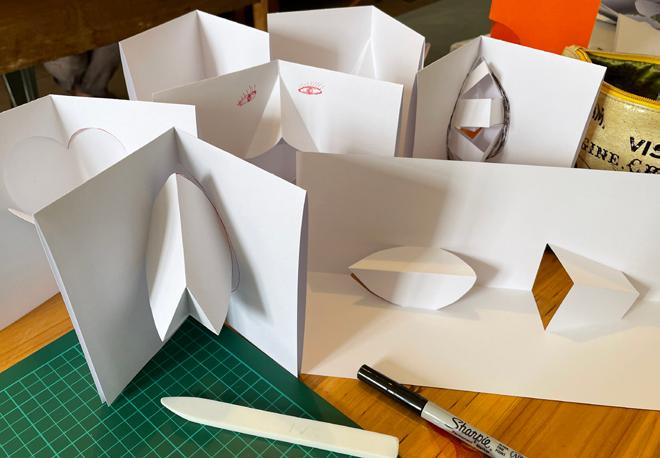
Right: Beth Anna Stockdell's star pop. Opposite: The view from the school terrace.


embellishment. There is no doubt that pop-ups apply these same engineering principles to paper.
We began with the basic hamburger and hot dog folds on a single sheet of paper, then cut into the bottom half of the hot dog fold. We then reversed the folds to create our first magical pop-ups. I was amazed, and from that moment, hooked. The fact that the finished piece had the immediate look of a greeting card or book page also opened my mind to the endless possibilities that even this most simple of pop-up forms offered. My baptism into pop-ups could have ended there and I would have considered this outing a grand success.
But there was more! Over the next two weeks we moved on to extensions, spirals, struts, and floating platforms, layered adhesive and non-adhesive props, and the most incredible of all: V-folds and three-dimensional straddle pops. Even with our limited tools and only the basic
ROYGBIV colors available in our stack of textweight and cover-weight papers, my classmates and I could hardly contain ourselves when the instructions for each session were over and Carol gave us the last hour or so to “play.” “Experiment” may have been the word she used, but we heard and felt it as “play.”
I also appreciated a fascinating slide show Carol presented during one class in which she traced the history of pop-ups, how they served early seafarers’ need to navigate by the movement of star constellations across the sky and gave life to some of the first human anatomy books that incorporated flaps and overlays to show the layers of bones, muscles, and circulatory systems in the body. She also taught us about pop-up pioneers Lothar Meggendorfer and Waldo Hunt, who popularized pop-up publishing for instruction and entertainment during their lifetimes.
Over the two weeks of The Art of Paper workshop, each student took four tracks of paper art exploration — papermaking, 3D paper objects, bookmaking, and pop-up art. Pop-ups was the practice I knew least about. I’ve been making paper and creating books for more than five years and began creating 3D objects under the guidance of Helen Hiebert about a year ago. I must now make space in my life for pop-ups, if for no other reason than the sheer joy they bring me and others with whom I’ve shared my simple creations.
Upon my return home from Italy, I immediately joined the Movable Book Society and look forward to the wonders this craft has yet to reveal. I will also never look at a folding chair in the same way again.
Many thanks to MBS members and Italy classmates Carol Barton, Beth Stockdell, Terry Englehart, and Lore Spivey (and MBS Member

and teacher Helen Hiebert, who was with us, although pop-ups weren’t her focus on this expedition) for encouraging and inspiring this novice popper-upper as I drank from the firehose of pop-up knowledge for two captivating weeks in Italy.

Ron Shaull is a freelance writer/editor based in Columbus, Ohio, and as of October 2022, a new member of the Movable Book Society.
 Group at winery (mostly MBS members) L-R around - Carol Barton, Denise Carbone, Beth Stockdell, Judy Bennett, David Voros (ICA Owner), Lore Spivey, Susan Buhler-Maki, Ron Shaull (author of article).
Some of Carol's artwork created while there.
Opposite left: A pop-up card by Carol.
Group at winery (mostly MBS members) L-R around - Carol Barton, Denise Carbone, Beth Stockdell, Judy Bennett, David Voros (ICA Owner), Lore Spivey, Susan Buhler-Maki, Ron Shaull (author of article).
Some of Carol's artwork created while there.
Opposite left: A pop-up card by Carol.

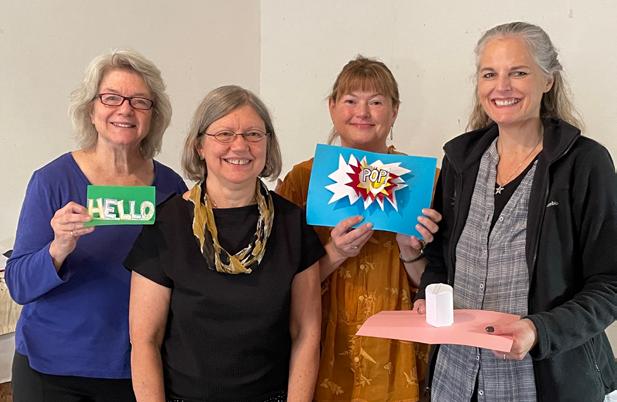

When two years ago my friend Cornel Rubino asked me if I’d be interested in teaching a pop-up class in Italy, I jumped at the chance. Italy is my favorite country to visit, and the Umbrian region where the International Center for the Arts is located encompasses beautiful medieval hill towns, vineyards, olive groves, and a unique cuisine — a setting sure to inspire creative exploration. But covid intervened, and the workshop was twice cancelled.
Now, three years later, director David Voros wanted to hold the pop-up workshop within an expanded curriculum of paper-based learning, so I contacted three of my colleagues who specialize in various aspects of the paper arts to see if they would join me as instructors in the town of Monte Castello di Vibio, Italy. With all of them on board, our 2022 ICA Paper Session was launched.
Paper takes so many forms. It can be an art in itself, can be bound into books, can mechanically move as pop-ups with the turn of a page, and can be formed into objects, both practical and decorative. Our session was a sampler of these applications. Participants formed and dyed their own paper sheets in Amanda Degener’s class, sewed and tacked pages together into books under the tutelage of Denise Carbone, and lit up the night with paper lanterns, balloons, and translucent shadow boxes following Helen Hiebert’s instructions. For my part, I led students through a series of basic popup forms—floating platforms, straddles, props, and V-folds. Then let everyone loose to try their hand at designing their own constructions.
What was unique about this session was the exploration of paper from so many different angles. Students came to appreciate the adaptability of a basic paper sheet — it’s strength, it’s transparency, it’s kinetic potential. But even more magical was the entire experience of being in a beautiful Italian hill town with incredible views of the surrounding landscape, delicious four-course
meals prepared and served by two incredible chefs, Katia and her nephew Federico, and the comradery that quickly developed between a group of fourteen excited and inspired people, eager to try new things and explore new processes.
Our group took several excursions when we weren’t in the classrooms. Most informative was a trip to the town of Fabriano, where the manufacture of handmade paper began in the 13th century and continues to this day. There, the paper museum features demonstrations of early papermaking equipment and paper forming, along
with displays of paper money, watermarks, and artworks. On subsequent trips to Perugia, Florence, and Orvieto, we were not only able to visit museums and attractions, but also found Italian pop-up cards, small leather-covered notebooks, and marbled papers in the shops.
As a teaching experience, this session was a joy. Unlike a short two-day workshop, the longer session allowed me more time to get to know the students and to help them discover their strengths within the paper medium. Being in a new place
provides creative stimulation which can continue to feed one’s art long after the return home. And making new friends who share your passion is always exhilarating. Pop-ups in Italy? Perché no?

Opposite top: Helen demonstrating paper making.
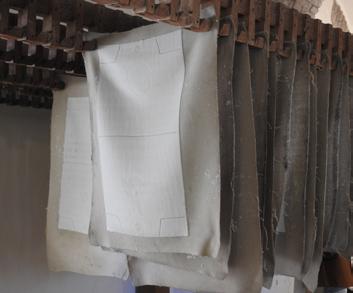
Left: Denise teaching a book binding technique.
Far right: Amanda shows a student an eastern form of paper making.
Bottom: Carol discusses the history of paper engineering. © Ron Shaull
Below: Paper hanging at Fabriano. Middle page: The instructors, Denise Carbone, Carol Barton, Helen Hiebert, and Amanda Degener.

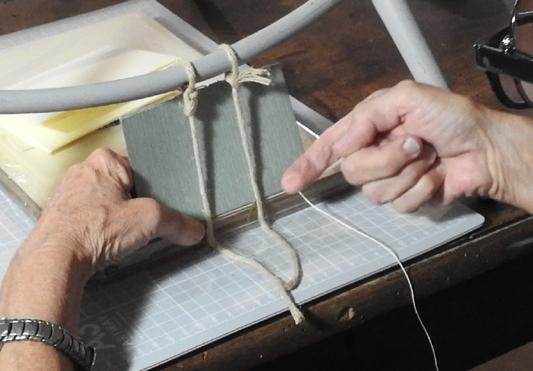

This page: The fruits of our labor. Student work displayed at our farewell party.

Opposite page:
Upper left: Amanda shows how Kozo is cooked.
Upper right: Helen shows off Beth Stockdell's inflatable paper balloon.
Middle: Paper lanterns made in class.
Bottom: Ciao! card by Terry Englehart. Photo © Terry Englehart





Paper Engineering has rarely been more thrilling than in Peter's working model of the Dream Faire inserted into and unfolded in the Netflix stopmotion film Wendell & Wild.
If paper engineering were an Olympic sport, I think we might agree that Germany just took the first Gold.
-Editor


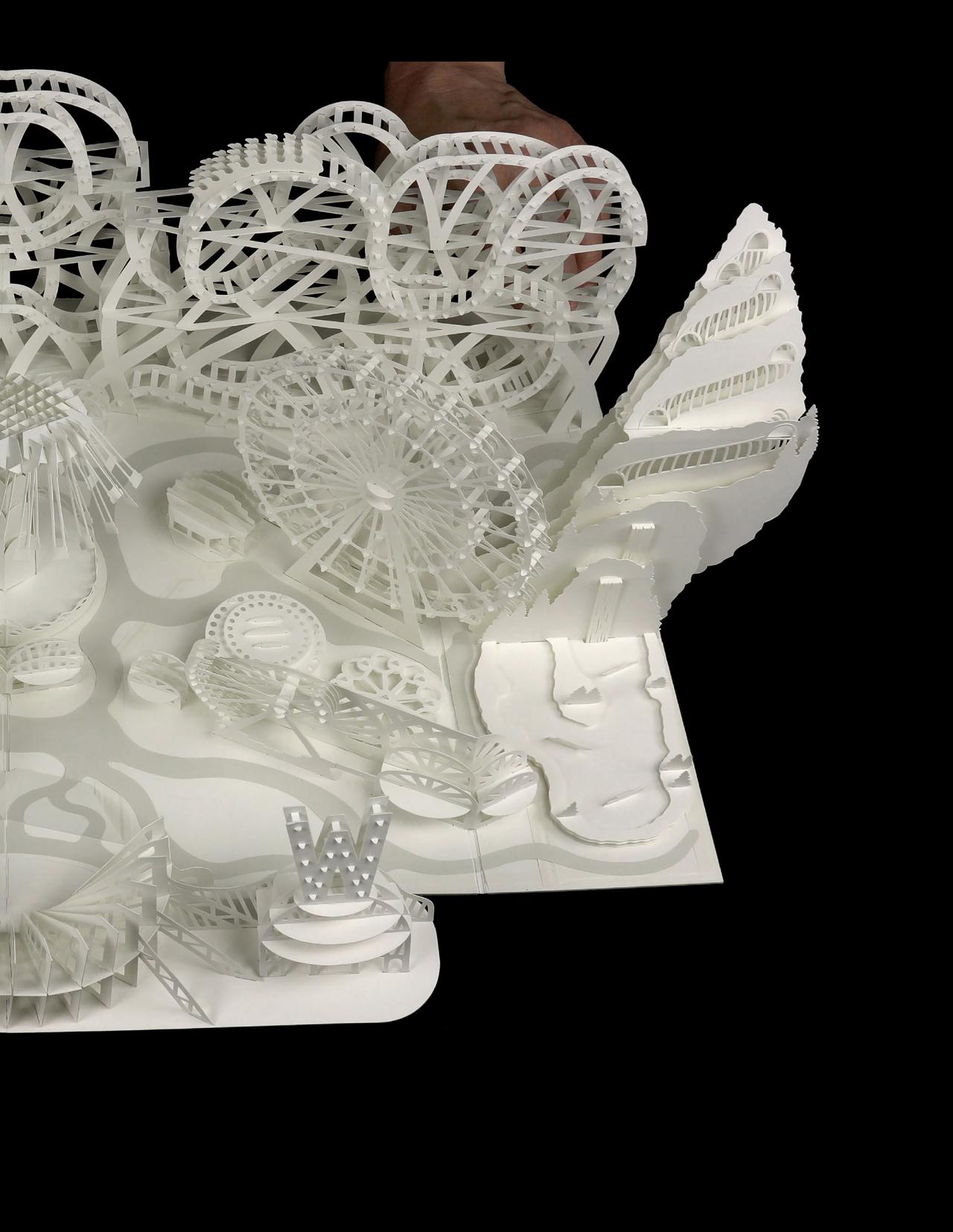 By Peter Dahmen
By Peter Dahmen
October 2019, I received a request from the film production company Prodicle. Later the project was taken over by Netflix Animation, Netflix's own production company. After signing a nondisclosure agreement, the production company sent me the first 27 minutes of a storyboard for a planned stop-motion animation film. In this animation technique, real models are built (not in the computer, but in the real world), which are then moved and photographed piece by piece. By quickly playing the individual images one after the other, the impression is then created as if everything was really moving.
I received the order and a contract at the end of December 2019. I started working on this project the first week of January 2020.
In the original version of the storyboard, it was intended that the two main characters Wendell and Wild hold in their hands a project planned by them, the dream amusement park - The Dream Faire, not as a drawing or architectural plan, but already as a threedimensional model. Since the two characters wanted to keep this project secret, they had to hide it from prying eyes. Henry Selick, the director, had the desire to build this model as a popup sculpture. Although it would have been possible to simulate a pop-up model using the stopmotion trick technique, Selick wanted a REAL pop-up to be used in the scene. My task was to design and build a complete amusement park out of paper and cardboard that would unfold from a flat folder, and fold back into a flat object just as easily.
1As far as I know, Harrod was the ONLY production designer at that time. However, he left the company about a year before the film was completed or about a year after the pop-up scene was completed. I do not have exact background information on this. On IMDB.com there are now THREE production designers listedand all only as COproduction designers. Unfortunately, I don't have more detailed info on this.
Photos in this article © Peter Dahmen unless othewise identified.
As a guideline,
I had only the very vague drawings from the storyboard. The pop-up was to be made of white cardboard so I could not use any colored elements and/ or illustrations. The exact design of the park, also the selection and arrangement of the carousels, was completely up to me. When coordinating the technical features with the production designer Paul Harrod.1
It became clear very quickly that I would not be able to build the overall scene on a scale that corresponds to the size of the stop motion puppets.
The pop-up would have been allowed to have a size of only a few centimeters in the original size that fits the dolls when closed (8cm x 14.4cm ... open 24cm x 14.4 cm).
We agreed that I could build the model in a larger scale, proportionally correct, of course. My model was to have the following dimensions when closed: 36 x 20 cm. When unfolded, the footprint would increase to about three times the width - about 60 cm.
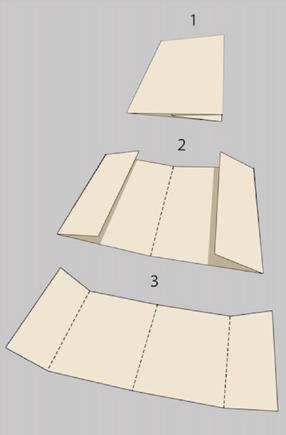
My final model grows not only in width, but also in height, so that the final dimension of 61 cm x 43cm x 22cm is again significantly larger than the expected dimension of 36 x 60 cm).
It was also specified that the pop-up should open in two steps: First, it should be unfolded along the main axis, the centerfold. Then, in a second step, two more flaps were to be opened on both sides. Theoretically, the model could also be opened in THREE steps - first the center, then one side, and finally the other. But in the movie, both sides are opened at the same time.

The film production company didn't give me any specifications for the design of the amusement park. In the storyboard, the amusement park looked completely different, depending on the storyboard artist. I had artistic freedom in the design. As a first step, I built various rough pop-up models that did not yet represent any actual rides or carousels. My only concern in this first design phase was to combine as many different folding mechanisms as possible on ONE base sheet. Each of these modules should unfold into a three-dimensional model. Of course, it was also important that the individual modules would not interfere with each other when opening and closing. It was also important to me to design a scenery in which the individual elements move in different directions when opening and closing (sideways, forward, upward, diagonally...).
For this purpose - and also for a first presentation of ideas, I designed (and built) many smaller pop-up modules, which I could attach to the large base area. So I could test the effect and the technical properties.
I presented these first test models to the film team in a video conference. I was very excited, because the director was also there - and my models were (after a week of work) still far from looking the way I actually intended. But this first presentation was a complete success - Selick and his team were thrilled. However, they did express one specific wish: The theme park should definitely also feature a large roller coaster.
In the next step, I therefore concentrated on the development of a roller coaster. One difficulty at first was to design a large, coherent shape (or at least a shape that
gives the impression of being coherent) that opens up in three steps. So, as usual, I first designed the basic, three-dimensional collapsible structure seen above.
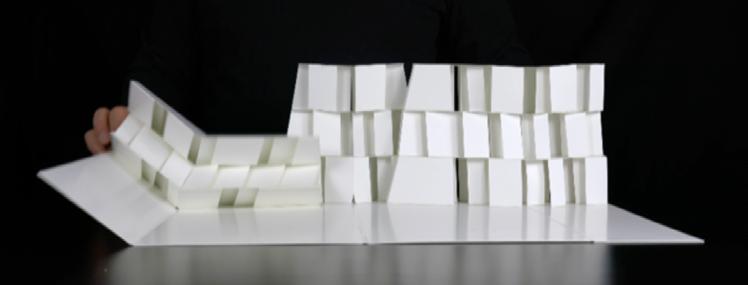
After many failed attempts (which kept me busy for about a whole week), I managed to design a structure that had all the properties from which I could later develop a roller coaster. My first models were (as always) cut by hand.
It was very important that the pop-up structure would not fold forward when collapsed, because otherwise it would have interfered with the pop-up structures in the foreground of the scene when opened. So I had to design the roller coaster in such a way that it folds vertically into itself or into its ground plan. Of course, I tested this again and again using real models.
I then further refined this newly developed basic structure. In many intermediate steps and after building several models, my model started to look like a real roller coaster. Only

when all the details work the way I want them to, I used the information and dimensions from my handmade models to rebuild them in a vector program (Adobe Illustrator). This allows me to further refine and optimize the measurements and details in the computer. However, that doesn't mean I could now complete the models entirely on the computer - I had to keep cutting
out the elements and assembling them by hand into real pop-ups. Only by testing by hand could I further optimize my designs. Because of the many components, assembling one of these intermediate models often took several hours. However, the complexity of my design created a new problem: assembling the individual parts was very difficult, because dozens of tiny parts

had to be glued together. Minor inaccuracies, unavoidable during assembly, meant that the model did not fold as flat as I had imagined. The model was too thick.
The next module I designed was the swing ride, as seen in the inset to the left. Here, too, I initially built several models, which were used in many experiments. Details were still lacking - but I learned something new with each model, so that little by little (through trial and error) I was able to develop a working –and good-looking – model.
For the third model of this scene, I needed significantly less development time. After about another week, I was able to present a Ferris wheel pop-up model to the film team. Of course, it was important that all the carousels could be opened and closed simultaneously and without interfering with each other in the overall scene. So I not only had to design the individual carousels as a pop-up (as I did throughout the entire design process), but I also had to always keep in mind that they would also function without problems in the overall scene.
In total, I worked on the development of this model for almost five months. The finished model consists of more than 1370 individual parts. Alone with the assembly of the final model I was busy for 74 hours.
On May 18, 2020, I sent my model by courier to the film production company in Portland. In addition, I made detailed assembly instructions for each element and provided vector data to the film production company. The assembly instructions I made for the film production company so they could recreate my model consists of 114 pages.
I solved this difficulty by changing many joints (where I originally wanted to join the parts with glue) now to plug-in joints (slots and tabs). This had several advantages: Assembly was much faster, yet more precise - and the model was now much flatter when folded. After I had successfully tested my concept on a section of the roller coaster, I designed the entire roller coaster in detail. This took me another two weeks - as it consists of many hundreds of parts. The presentation of my finished model was very well received by the film team.
In the meantime, the film team had decided to adjust the story a bit. The two main characters, Wendell and Wild, were no longer to be shown in the first scene with the assembled pop-up model. Instead, they should now be shown crafting the pop-up scene. To this end, I sent the information (assembly instructions and vector data) for my Ferris Wheel and Swing Ride models to the film crew in Portland, Oregon, who developed significantly scaled-down versions from them. Since the Wendell and Wild character puppets are only about 30 inches tall, my models had to be scaled down significantly to fit the proportions of the stop-motion puppets.
Over the next few weeks, I gradually designed more carousels - with lots of little details. The procedure was always the same for me: First I developed the basic technical structure, which can be folded together perfectly and unfolds just as perfectly. Only in the next steps – and with the help of many handmade models – did I develop the shape that then looks like the desired motif (e.g., a carousel).

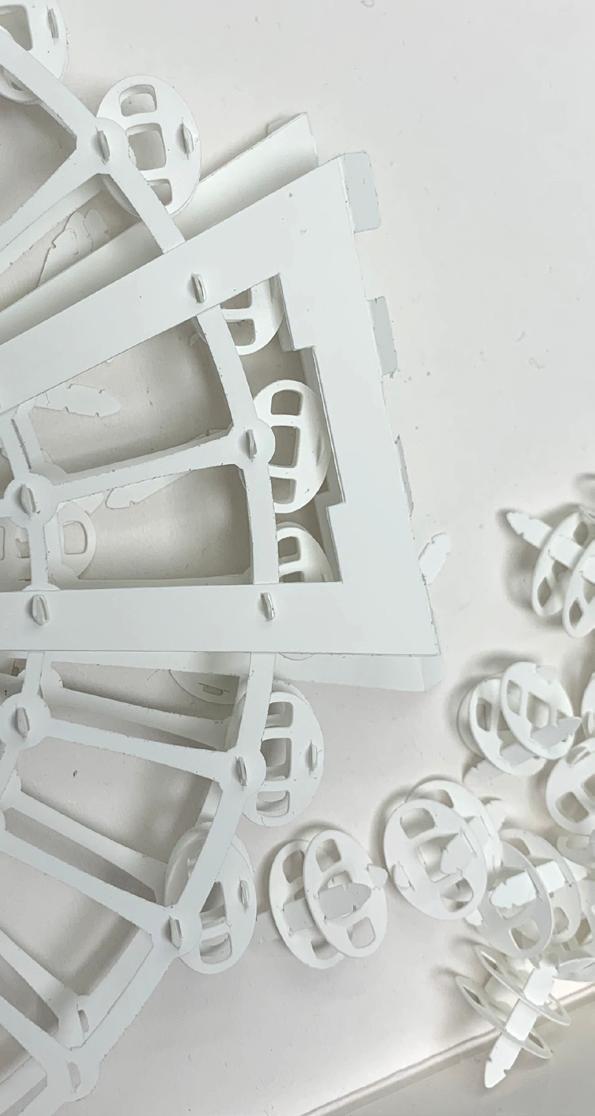
At least two models were used to animate the movie scene, which features the entire amusement park. When the pop-up opens, you can see my original pop-up model. Once the pop-up is completely open, all the carousels move. To make this possible, one more identical looking model was made by the stop-motion animation artists according to my design specifications. In this version, the model can no longer be folded - but all the carousels move.
The movie was released on Netflix on October 28, 2022. I was blown away by how wonderfully the stop-motion animation artists staged the pop-ups.
I made all the pop-up elements from Invercote G (Manufactured by Iggesund/The Holmen Group). For most of the elements I used Invercote with the weight of 220 g/m². This material offers a very high bending stiffness but is much thinner than other materials. The backing sheet (the base) of the pop-up is made of sturdy Bristol board with a weight of 925 g/m².

As seen on IMDB:
Synopsis: From the delightfully wicked minds of Henry Selick and Jordan Peele, comes Wendell & Wild, an animated tale about scheming demon brothers Wendell (Keegan-Michael Key) and Wild (Peele) - who enlist the aid of Kat Elliot - a tough teen with a load of guilt - to summon them to the Land of the Living. But what Kat demands in return leads to a brilliantly bizarre and comedic adventure like no other, an animated fantasy that defies the law of life and death, all told through the handmade artistry of stop motion.
Premiered: October 28, 2022
Directed by: Academy Award®-nominee Henry Selick
Written by: Henry Selick & Academy Award ®winner Jordan Peele
Producers: Henry Selick, Ellen Goldsmith-Vein for The Gotham Group, Jordan Peele and
Win Rosenfeld for Monkeypaw
Executive Producers: Lindsay Williams and Eddie Gamarra for The Gotham Group, Kamil Oshundara, Ian Cooper for Monkeypaw
Music by: Academy Award ®- nominee Bruno Coulais (Les Choristes)
Cast: Emmy award winning Keegan-Michael Key (Key and Peele) as Wild, Academy Award ® - winner Jordan Peele (Get Out, Us) as Wendell, as well as Lyric Ross (This Is Us), Angela Bassett (Black Panther), James Hong (Kung Fu Panda), Tamara Smart (A Babysitter's Guide to Monster Hunting), Natalie Martinez (The Twilight Zone), Tantoo Cardinal (Dances with Wolves), Gabrielle Dennis, Igal Naor, David Harewood, Maxine Peake, Ramona Young (Never Have I Ever), Sam Zelaya, Seema Virdi, Gary Gatewood, and Ving Rhames (Pulp Fiction)
Peter Dahmen, born in 1967, studied Communication Design at the University of Applied Sciences and Arts in Dortmund, Germany. He graduated in 1994 and since then has worked as a professional designer. Since his student time, he passionately creates three-dimensional folding objects out of paper and cardboard. For a long time, only a few people had seen his work. That changed when he published a short film of his paper sculptures in the year 2010 on YouTube. The response was overwhelming. Peter became a social media celebrity with millions of viewers of his YouTube, Facebook, and Pinterest pages. Since then, he has received commissions from companies worldwide.
Working as a freelancer, he has created amazing designs for major brand owners, including what is probably the largest pop-up ever in the world, for the press launch of the new MINI car (BMW Mini Cooper) in 2011. It was 10.5 meters wide and more than 5 meters high. In addition to collaborating with card manufacturing companies, he has designed amazing pop-up sculptures for the American magician Marco Tempest. Some of his exclusive pop-up card designs became best sellers at the MoMA Store in New York. For Iggesund paperboard, he created a spectacular Christmas Card, which is also a foldable decoration. It can be used to create thousands of different snowflake images.
Peter Dahmen's artistic paper pop-up sculptures have been presented at various international exhibitions, for example in the international exhibition "World Pop Up Art" in Seoul (2013) and Changwon (2014) in Korea and in the exhibition "Origami Universe: Pop-up Wonders" 2020-2021 at the Chimei Museum, Tainan City in Taiwan (R.O.C.).


 © Photo by Ibrahim Gonzalo
© Photo by Ibrahim Gonzalo




I am French, a visual artist paper art lover and collector of animated books.
I am also one of the editors of livresanimes.com and a member of the Movable Book Society.
As a collector, more than the desire to own, it is the desire to share with as many people as possible that drives me.
This is why, regularly for my visitors, I produce in my workshop a showcase of 10 to 12 non-exhaustive animated books, devoted to a theme. I have treated for example "the gardens", "the school", "the circus", etc.


I started in February 2017, and I am now on my twentieth showcase. Until now I was content to take a picture of it and post it on my own Facebook page. But since April 2022, I have also decided to systematically make a short video of it, quickly presenting each book on display. This makes it possible to make these albums, whose vocation is precisely to be animated, more alive!
I dedicate myself to this exercise when my artistic activitycreation, exhibitions, animations - allows me. But it entertains me, and I take real pleasure in it. In addition, it is an excellent way for me to bring my collection to life and thus rediscover certain works. On this and the following page please enjoy videos that I post to accompany the displays.
And this pooling enabled by social networks, which the Movable Book Society is now relaying, is also very pleasing to me.
PS: I myself am the author of two very special animated books. Please, enjoy a video of one of them, Voyage d'une Goutte de Pluie.

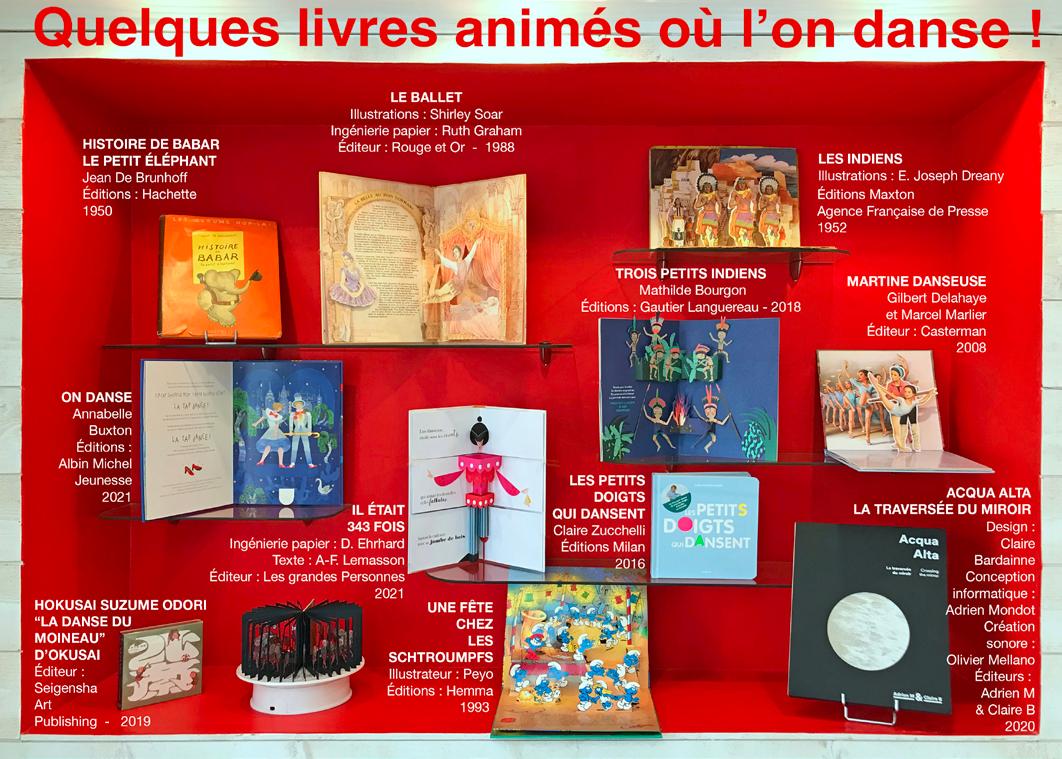

"There are a thousand ways to travel and in these equivocal times I found a way to travel the world without having to feel guilty about a disastrous carbon footprint. I simply opened some of my animated books and went for a walk on paths full of surprises. In a hot-air balloon, in a sidecar, in a horse-drawn carriage, in a boat... in the company of a little mouse, on the back of a swallow, escorting a crocodile, I put my feet and my head on the continents of imagination.
Since my showcase is not expandable, I only retained 11 titles, many of which were published in the last century; nostalgia for a time when traveling probably had more meaning than today.

Be that as it may, travel shaping the young, know ladies and gentlemen that these escapades are unparalleled in awakening and enchanting this precious part of childhood that lies dormant in us."
Other collections displayed by Daniel:
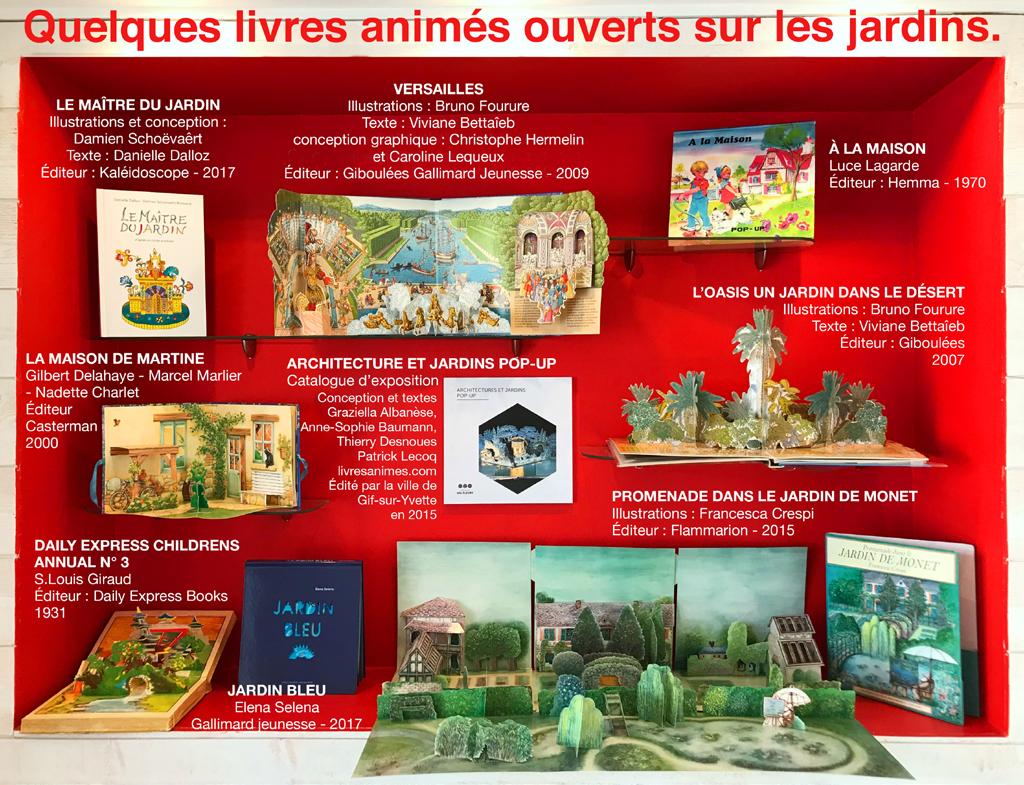
ARBRES (Trees) CHÉVRES (Goats) COCORICO (Cockadoodle Doo)
L'ESPACE (Space)
ÉCOLE (The School)
FLEURS (Flowers)
HIVER (Snow) OISEAUX (Birds)
PAPILLONS (Butterflies)
PÉRE NOËL (Santa Claus)
PEUR (Fear) PINOCCHIO (Pinocchio)
SEXE (Sex)
MARVEL SUPERHEROES, THE ULTIMATE POP-UP BOOK


PE: Matthew Reinhart Abrams Books for Young Readers November 15, 2022 978-1419749117 $38.25
POP-UP PEEKABOO! SHARK PE: Maike Biederstädt DK November 29,2022 978-0744059274 $12.99

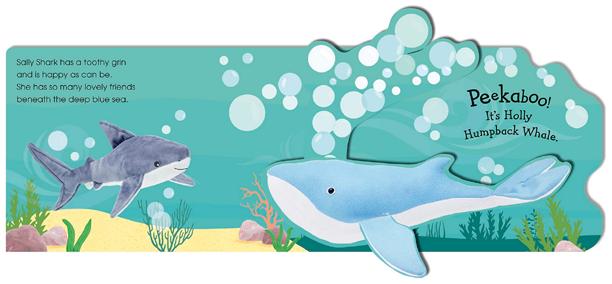
ANDY WARHOL POP-UP POP ART
PE: Rosston Meyer Poposition Press December, 2022 979-8-9854695-0-9 $60


PE: David Hawcock Nuinui Jeunesse October 7, 2022 978-2889572694 14,90 Euro

*EDITOR'S NOTE: PAPER ENGINEER FOR POP-UP BUTTERFLIES : Jenny Hilborne This book appeared in last edition, but PE was incorrectly identified.

*EDITOR'S NOTE: PAPER ENGINEER FOR POP-UP PEEKABOO! OCEAN: Maike Biederstädt. This book appeared in last edition, but PE was incorrectly identified.

PE: MinaLima Harper Design November 8, 2022 978-0063208247
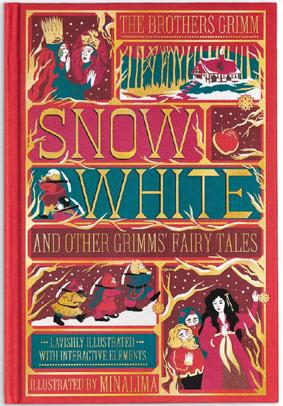
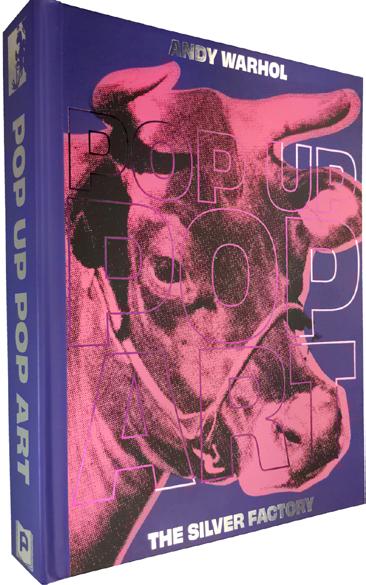




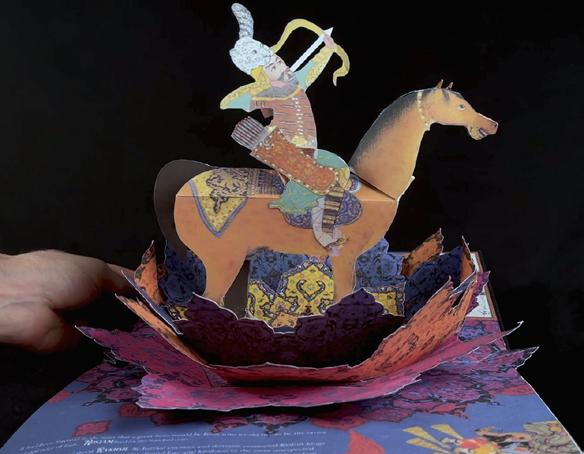

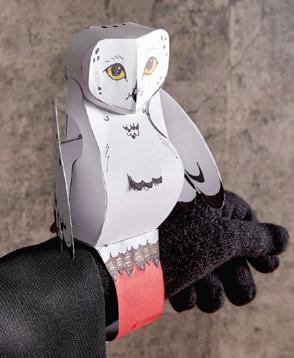
Interested in books? How about a scholarship to follow your bliss? Look into this website.
The Next MBS Conference-2023 Please join us in Cleveland, Ohio for our next conference, September 28-October 1, 2023 There is an exciting program prepared and the more the merrier. The MBS conference may also be attended virtually. Be there! Log onto the MBS website, movablebooksociety.org, or the Facebook page, for more information.
California Book Fair, Pasadena Convention Center, Pasadena, CA; February 10-12, 2023; Savannah Book Festival, Savannah, Georgia; February 18, 2023; Los Angeles Times Festival of Books, Los Angeles, California; April 22-23, 2023; Billed as “the largest book festival in the country.”
Papermania Plus! January 14-15, Hartford, CT.
Ephemera 43 Conference, Show, and Sale. March 17-19, Old Greenwich, CT. There are many more ephemera shows listed at this site.
A positive result of COVID is the creation of virtual book fairs. Shop from the comfort of your computer. The Popuplady has added to her collection successfully from several of these fairs.
The largest aggregation of fairs is provided by Getman. Check the website for up-to-date information. Rare Book and PaperPalooza, Jan. 13-15.
Dealers clear their shelves to make room for new inventory. Thousands of rare and vintage books and ephemera priced from $25 to $15,000.
Pop-up books through the Ages opens at Chicago’s Newberry Library on March 21, 2023, until July 15, 2023. Drawn largely from the Library’s collection, the exhibit is curated by
Suzanne Karr Schmidt, the keynote speaker at our Denver conference.
In addition to exploring the past, the exhibition highlights the present and future of pop-up books, including the work of contemporary book and paper artists who are pushing the form in new directions. Two of these artists, Hannah Batsel and Shawn Sheehy, have even designed a pop-up version of the Newberry that you can take home and construct yourself! The Library is open to the public and is free of charge.
seminar on the conservation of movable books on December 14, 2022. The Zoom meeting is available. Closed captioning may be toggled to several languages.
They are collecting contributions in view of the publication of the new issue of JIBJournal of Interactive Books scheduled for April 2023. JIB welcomes original scientific contributions, reports and reviews of exhibitions, presentations of creative activities of pop-up designers.
To submit an article as an author you need to register at this link
The deadline for sending the contribution is February 15, 2023. To read the guidelines and make a submission click here: JIBSUBMISSIONS
From TANU Creative: Four in One Pop Explosion boxes.
Animated Advertising: 200 Years of Premiums, Promos, and Pop-ups: from the Collection of Ellen G. K. Rubin
On until Feb. 11, 2023, at the Grolier Club, NYC.
If you gave me one of your movable business cards, perhaps it is in the exhibit and in the 112-page color catalog. There are QR codes throughout the exhibit to see some of the objects move. See here for more images and video.

Here is a video showing how to wrap presents using a combination of origami and paper engineering.
The International Center on Interactive Books in Turin, Italy, held a

Eric Hluchan, of Structural Graphics and one of our presenters at the Denver Conference, has won a Marcom award for his pop-up shoe.
Robert Sabuda was recently in the news for his humanitarian efforts to support a family of Afghan refugees settling in the Hudson Valley. Robert's largess and philanthropy is of course well known to and admired by members of MBS.

This set of three pop-up greeting cards includes:
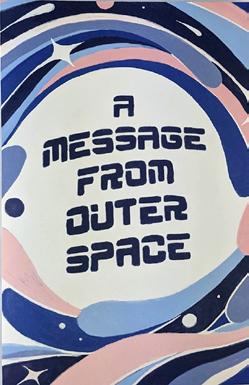
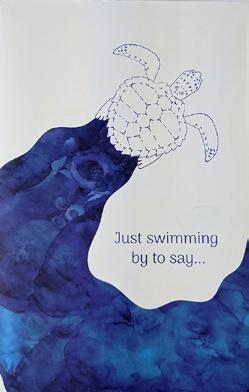
Awesome Turtle designed by Keerthana Ramesh Holiday House designed by Paper Paul Space Cat Pop-Up Birthday Card designed by Star Shen
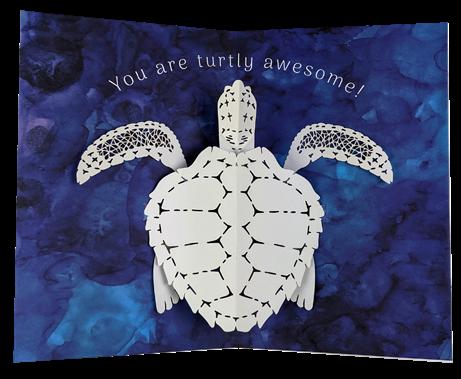
Each card opens flat to 8.5″ x 11″ and comes in a white A9 envelope.


